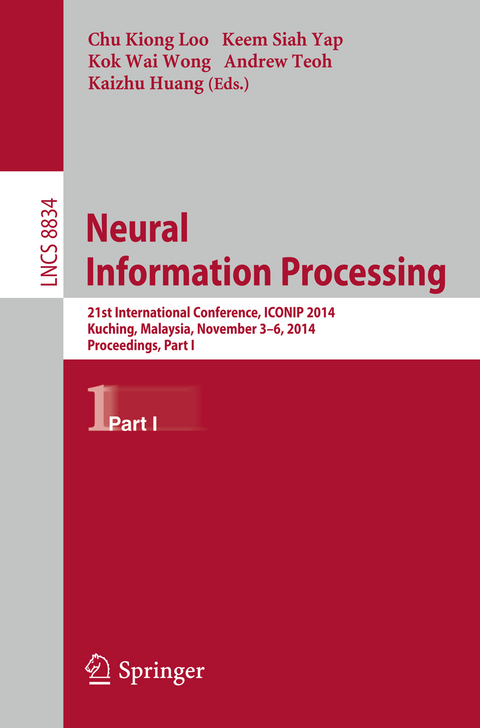
Neural Information Processing
Springer International Publishing (Verlag)
978-3-319-12636-4 (ISBN)
Cognitive Science.-Transfer Entropy and Information Flow Patterns in Functional Brain Networks during Cognitive Activity.- Human Implicit Intent Discrimination Using EEG and Eye Movement.- Towards Establishing Relationships Between Human Arousal level and Motion Mass.- Estimating Nonlinear Spatiotemporal Membrane Dynamics in Active Dendrites.- Inter Subject Correlation of Brain Activity during Visuo-Motor Sequence Learning.- An Agent Response System based on Mirror Neuron and Theory of Mind.- Dynamic of Nitric Oxide Diffusion in Volume Transmission: Model and Validation.- A Computational Model of the Relation Between Regulation of Negative Emotions and Mood.- Neural Networks and Learning Systems - Theory and Design.- Low-cost Representation for Restricted Boltzmann Machines.- Add-if-Silent Rule for Training Multi-layered Convolutional Network Neocognitron.- Posterior Distribution Learning (PDL): A Novel Supervised Learning Framework Including Unlabeled Samples Distribution into Decision.- Computational Model of Neocortical Learning Process: Prototype.- Active Learning with Maximum Density and Minimum Redundancy.- One-to-Many Association Ability of Chaotic Quaternionic Multidirectional Associative Memory.- An Entropy-guided Adaptive Co-construction Method of State and Action Spaces in Reinforcement Learning.- A Nodes Reduction Procedure for RBFNDDA through Histogram.- Toroidal approximate identity neural networks are universal approximators.- Self-Organizing Neural Grove.- Transfer learning using the Online FMM model.- A supervised methodology to measure the variables contribution to a clustering.- Coupling between spatial consistency of neural ring and local eld potential coherence: A computational study.- Fading channel prediction based on self-optimizing neural networks.- Invariant Multiparameter Sensitivity of Oscillator Network.- Spatial-Temporal Saliency Feature Extraction For Robust Mean-Shift Tracker.- BOOSTRON: Boosting Based Perceptron Learning.- G-Stream: Growing Neural Gas over Data Stream.- Combining Active Learning and Semi-Supervised Learning Using Local and Global Consistency.- Complex-Valued Neural Networks -- Recent Progress and Future Directions.- A Cascade System of Simple Dynamic Binary Neural Networks and Its Sparsification.- A Model of V4 Neurons Based on Sparse Coding.- A fast and memory-efficient hierarchical graph clustering algorithm.- Hopfield-Type Associative Memory with Sparse Modular Networks.- Concept Drift Detection based on Anomaly Analysis.- Online learning for faulty RBF networks with the concurrent fault.- The Performance of the Stochastic DNN-kWTA network.- Modularity maximization adjusted by neural networks.- A dynamic pruning strategy for incremental learning on a budget.- Neural Computing with Concurrent Synchrony.- A Line-partitioned Heteroassociative Memory for Storing Binary Fresnel Hologram.- A Unified Framework for Privacy Preserving Data Clustering.- Spiking Neural Network with Lateral Inhibition for Reward-based Associative Learning.- Fuzzy Signature Neural Networks for Classification: Optimising the Structure.- Self-Organizing Map-based Probabilistic Associative Memory.- Neural Networks and Learning Systems - Applications.- A Causal Model for Disease Pathway Discovery.- Enhanced Non-linear Features for On-line Handwriting Recognition Using Deep Learning.- Recognizing Human Actions by Using the Evolving Remote Supervised Method of Spiking Neural Networks.- A Neural Networks Committee for the Contextual Bandit Problem.- Multi-step Predictions of Landslide Displacements based on Echo State Network.- Discrete-Time Nonlinear Generalized Policy Iteration for Optimal Control Using Neural Networks.- ANFIS-Based Model for Improved Paraphrase Rating Prediction.- Contextual Bandit for Active Learning: Active Thompson Sampling.- Choosing the Best Auto-encoder-based Bagging Classifier: An Empirical Study.- Classification of fMRI Data in the NeuCube Evolving Spiking Neural NetworkArchitecture.- A hybrid approach to pixel data mining.- A Novel SOH Prediction Framework for the Lithium-ion Battery using Echo State Network.- Significance of Non-edge Priors in Gene Regulatory Network Reconstruction.- Robust Lane Detection Based On Convolutional Neural Network and Random Sample Consensus.- Learning Local Receptive Fields in Deep Belief Networks for Visual Feature Detection.- Adaptive Wavelet Extreme Learning Machine (AW-ELM) for Index Finger Recognition Using Two-Channel Electromyography.- Text Categorization Using an Automatically Generated Labelled Dataset: An Evaluation Study.- Online Recommender System Based on Social Network Regularization.- A Nonlinear Cross-site Transfer Learning Approach for Recommender Systems.- Deep Learning of Multifractal Attributes from Motor Imagery Induced EEG.- A Fast Neural-Dynamical Approach to Scale-Invariant Object Detection.- Improving Quantization Quality in Brain-inspired Self-organization for Non-stationary Data Spaces.- Utilizing High-Dimensional Neural Networks for Pseudo-Orthogonalization of Memory Patterns.- Adaptive Noise Schedule for Denoising Autoencoder.- Modeling Bi-Directional Tree Contexts by Generative Transductions.-A Novel Architecture for Capturing Discrete Sequences Using Self-Organizing Maps.-An Improved Gbest Guided Artificial Bee Colony Algorithm for Classification and Prediction Tasks.- Artifact Removal from EEG using a Multi-Objective Independent Component Analysis Model.-Cooperative Feature Level Data Fusion For Authentication Using Neural Networks.-Fuzzy Output Error as the Performance Function for Training Artificial Neural Networks to Predict Reading Comprehension from Eye Gaze.-Part-based Tracking with Appearance Learning and Structural Constrains Estimation of Hidden Markov Chains by a Neural Network.-Corporate Leaders Analytics and Network System (CLANS): Constructing and Mining Social Networks among Corporations and Business Elites in China.-Characteristics and Potential Developments of Multiple-MLP Ensemble Re-RX Algorithm.
| Erscheint lt. Verlag | 6.11.2014 |
|---|---|
| Reihe/Serie | Lecture Notes in Computer Science | Theoretical Computer Science and General Issues |
| Zusatzinfo | XXXIV, 635 p. 258 illus. |
| Verlagsort | Cham |
| Sprache | englisch |
| Maße | 155 x 235 mm |
| Gewicht | 1015 g |
| Themenwelt | Informatik ► Datenbanken ► Data Warehouse / Data Mining |
| Informatik ► Grafik / Design ► Digitale Bildverarbeitung | |
| Informatik ► Software Entwicklung ► User Interfaces (HCI) | |
| Informatik ► Theorie / Studium ► Künstliche Intelligenz / Robotik | |
| Schlagworte | activity recognition • Artificial Intelligence • Big Data • bio-inspired computing • brain-computer interface • Cellular Automaton • Cloud Computing • clustering and classification • Decision Support Systems • digital signal processing • Image Processing • Kernel Method • knowledge extraction • machine learning • machine learning theory • multi agent system • Neural networks • Ontology • Particle swarm optimization • pattern recognition • Recommender Systems • Regression Analysis • Reinforcement Learning • Robotics • Social network • Support Vector Machines • Time Series • Tracking • Unsupervised Learning • Virtual machine • Web mining • Wikipedia |
| ISBN-10 | 3-319-12636-9 / 3319126369 |
| ISBN-13 | 978-3-319-12636-4 / 9783319126364 |
| Zustand | Neuware |
| Haben Sie eine Frage zum Produkt? |
aus dem Bereich


